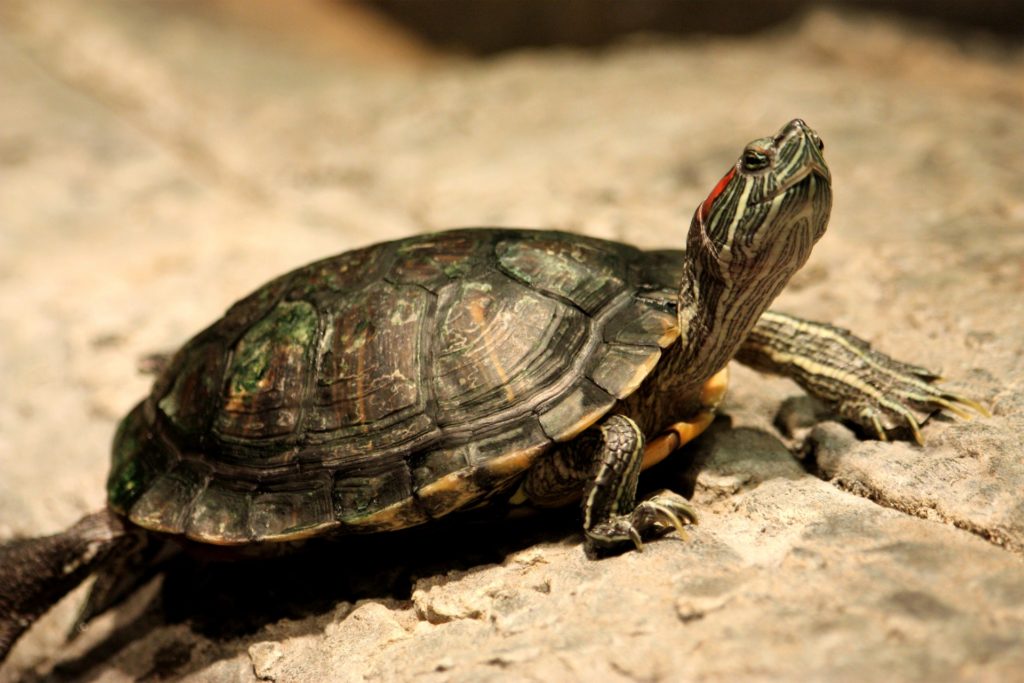
During the last real rain, when we got a little over 3 inches here, there was a turtle in the neighbor’s backyard. It was as big as a basketball, and strange to see here because our backyard is basically Santa Anna Mountain–not a place where there’s a ton of water. This turtle must have been waiting for it to rain, then tried to make a dash for greener pastures before it all dried up again, and made a wrong turn instead. The neighbors caught him, put him in a bucket, and gave him to my husband. Everyone hands their stray wildlife dilemmas to us. David loves turtles because we used to babysit his mom’s pet turtle years ago, and he developed a rapport with the turtle. It would alert him when it wanted to eat, and that turtle liked to have its head rubbed.
So David insisted on driving the stray turtle down to Pecan Bayou, as he was in danger from highways and dogs–namely my heeler pup who will harass the life out of any living thing he encounters. I tried to stop the removal, asking what would happen if he has a wife, how will he ever find her again? I guess David thinks he can pick up any number of wives downstream somewhere because he went on and moved it. Perhaps turtle wives are a dime a dozen, but I’m thinking it could also be hard to find a good one that sticks around. I decided to do some research on these turtles, to try and find out why so many seem to be crossing roads right now, getting into trouble and worse, and what to do when one comes along that needs help to survive.
Brown County Game Warden Allen Travis says that ninety-nine percent of the turtles we are dealing with right now are red-eared sliders. They go looking for new homes when their water dries up, and sometimes when there is too much water in a spot where they used to be comfortable. I am guessing it’s not because there is too much water!
The red-eared sliders are usually what you see sitting on logs in the middle of the bayou, or floating with their heads above water in ponds, creeks and lakes in our area. While they are considered an invasive species in many states, they are native to our area of Texas. I am guessing they call them ‘sliders’ because they will slide right into the water when you get too close, but if you sit still long enough, they’ll eventually crawl back onto their rock or log.
According to my reading, best practices for helping turtles that are migrating across your yard, or across roads and in other places where they shouldn’t be, are to pick the turtle up by the shell using two hands on either side. Move it to a safe place, pointed in the direction that it was traveling before it encountered danger. They say many turtles, like humans, travel by memory, so they can get confused if you put them down in a place they don’t recognize. If you are moving a turtle off a highway, make sure you park well off the road and watch for traffic while you carry out the work. I carry plastic gloves in the car, which are good to wear because turtles can carry salmonella, which is not something I want. A lot seem to get hit on downwards slopes in the road, maybe because that is where it’s more damp. I try to go slow over hills so I won’t crush one unexpectedly.
David the Turtle Man thinks he’s probably helped 7 or 8 of these turtles across the road in the past few weeks. I have noticed there seem to be a lot that are getting hit by cars lately, probably because so many tanks are dry and they’re forced to start looking for new homes. I guess not everyone loves turtles, but we are turtle people over here. They take life slowly, and so do we. We like to go down to the bayou and sit and watch the turtles in the morning. There is something so serene about watching a turtle bask in the morning light, like it’s charging up for the day, having its sunlight java maybe. We like to do the same.
***
Diane Adams is a local journalist whose columns and articles appear periodically on BrownwoodNews.com
